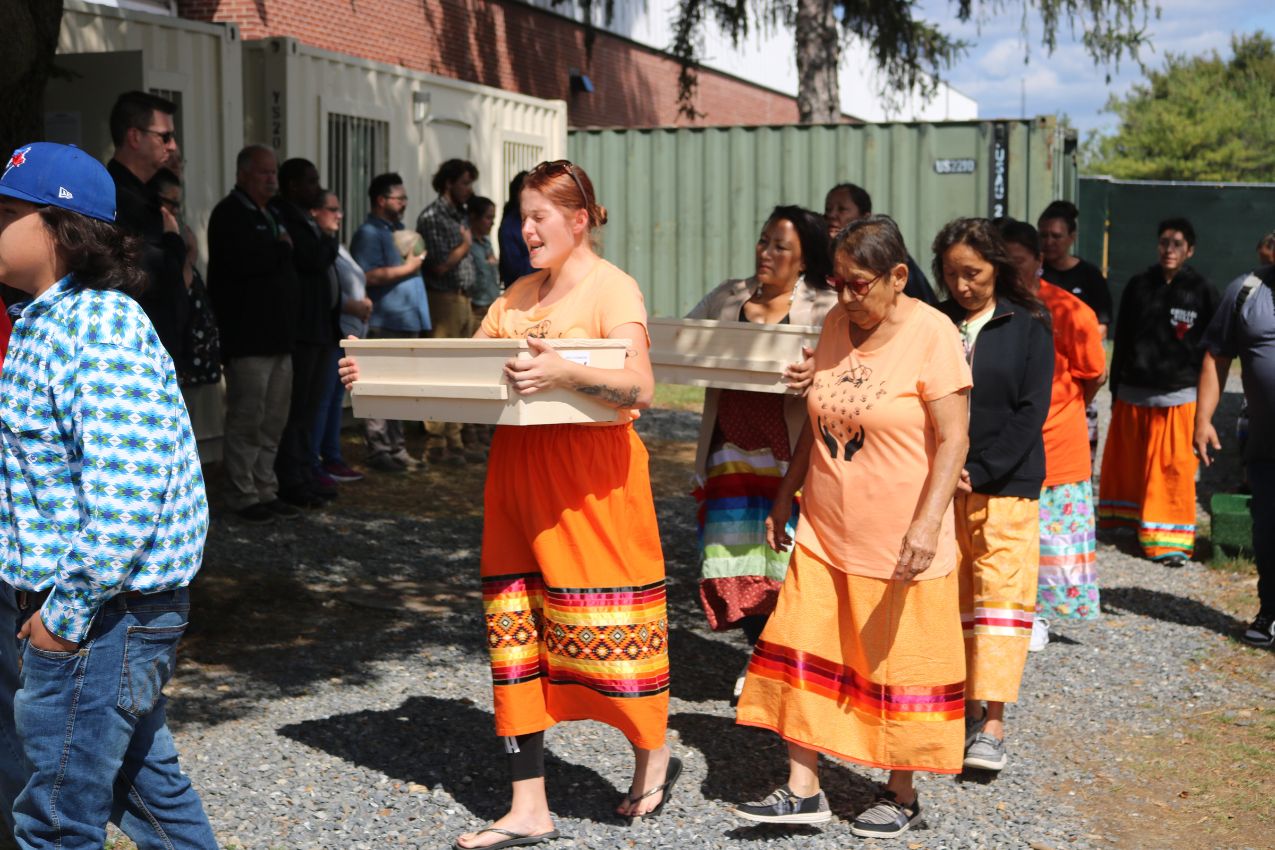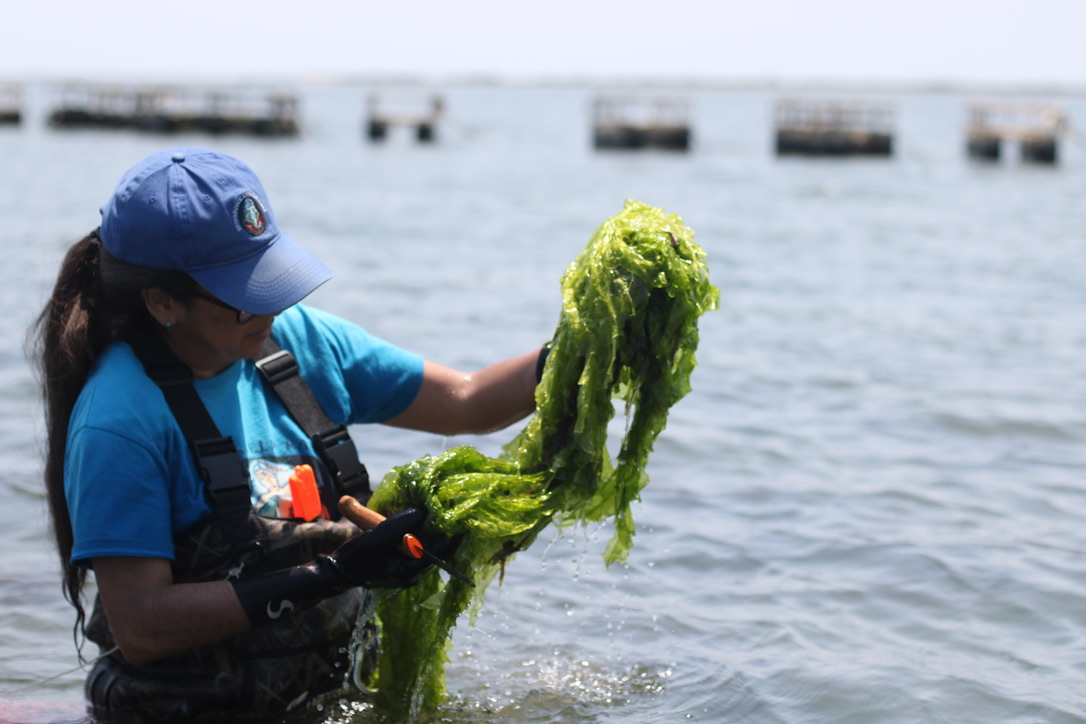
- Details
- By Native News Online Staff
Year in Review - 2023. Indian Country is full of great photo opportunities. From dancers dressed in beautiful and colorful regalia seen at powwows to the wise looks on the faces of Native American elders, our photographers work to capture the essence of Native America with respect to avoid accusations of exploitation while covering important stories in Indian Country.
Each Native News Online reviews hundreds of photographs to accomplany our articles. While difficullt, we have selected ten of our favorite photographs we used during 2023.
"Road to Healing" Visits Arizona to Hear from Boarding Schools Survivors, Decesendants

During 2023, Native News Online attended every Road to Healing tour hosted by the U.S. Department of the Interior. The Road to Healing tour provided our photographers to capture Native elders who survived the horrors of Indian boarding schools.
Pershlie Ami (Hopi), 67, attended the Phoenix Indian School. She recounted how when she was in the seventh grade, she signed up for an “outing” so she could leave the school premises and perform cheap labor for non-Native families.
“A family came and picked me up and took me to their home. The task that they wanted me to do was pick up dog poop in their house,” Ami said.
Ami says she refused to clean the house and was severely punished. She was never allowed to go out on another outing. | Read more
Buu Nygren, Youngest Navajo Nation President Ever, Inaugurated

Navajo Nation President Buu Nygren at his inauguration. (Photo/Levi Rickert)
Native News Online covered the inauguration of Buu Nygren who at 36 years-old became the youngest person ever to be elected to preside over the Navajo Nation that has the geographic size of the state of West Virginia.
In his inaugural address, Nygren thanked outgoing President Jonathan Nez for serving the Navajo Nation during the COVID-19 pandemic, which afflicted over 80,000 Navajo citizens and caused the death of almost 2,000.
Nygren committed to make every decision he makes as president based on whether or not the basic needs of the Navajo Nation will be met. | Read more
The Rise of Indigenous Doulas

Baby Graham wears traditional moccasins Shannon purchased for him at the The Daybreak Star powwow in Seattle. (Photo/Jessica Lázaro Moss)
A report published in early 2023 by the state of Washington health department shows that Native mothers there die eight and a half times more often than white mothers during pregnancy or within a year after–more than any other race.
That staggering dispartity alone was cause for Native News Online to this health inequity ample coverage.
More than 80% of all maternal deaths, the report found, were preventable. Although the problem is deeply rooted in systemic inequity for Black and Indigenous people in the United States, the solution is coming from the inside: In order to save Native mothers’ lives, Native mothers and aunties are taking on the cause themselves, by providing free physical, emotional, educational, and spiritual support to Indigenous mothers and their families before, during, and after their baby is born. | Read more
Faces of the Potawatomi Gatherng 2023

Established in the summer of 1994, each year the Potawatomi Gathering was established iby the Wasauksing First Nation to revitalize the Potawatomi culture, language, and identity.
Over 2,000 Potawatomi citizens from 11 Potawatomi tribal nations gathered this past week in southwest Michigan at the Pine Creek Indian Reservation, near Battle Creek and the Nottawasseppi Huron Band of the Potawatomi's Firekeepers Casino Hotel for the Potawatomi Gathering 2023.
The Potawatomi Gathering kicked off on last Monday in July with language workshops, On Thursday, Potawatomi leaders met to discuss common issues and on Friday the Potawatomi Economic Summit was held to discuss the various means each tribe is improving tribal business enterprises owned by the Potawatomi tribal nations. | Read more
'It’s happy sad': Two Oyate Boys Leave Carlisle, Others Left Behind

Angeline Wanna (left), Sisseton Wahpeton assistant archivist, sings as she carries the coffin holding Amos LaFromboise, the first documented child to ever die at Carlisle Indian Industrial School 144 years ago, to the tribal van bringing him home. (Photo: Jenna Kunze)
Smudged sage billowed into the air on Tuesday, September 19, as members from the Sisseton Wahpeton Oyate tribe of South Dakota and Spirit Lake Tribe of North Dakota carried small wooden coffins at Carlisle Indian cemetery containing their relatives’ remains to the tribal van that would bring them home after nearly 150 years away.
Around them, a crowd of tribal members and Army staff gathered, many with clasped hands and bowed heads.
Going home were two Oyate boys: Edward Upright (Spirit Lake Nation) and Amos LaFromboise (Sisseton Wahpeton Oyate). The boys left their homes in the Dakotas in 1879 when they were 13 and 12 years old, respectively. They were each the son of a powerful tribal leader—Amos of Joseph LaFromboise, a founding father of his tribe, and Edward of Chief Waanatan—in line to become hereditary chiefs of their respective tribes when they grew older. Instead, they never left Carlisle: They both died before they turned 16. | Read more
Lighting Up Navajo Nation

Shirley Chi on her family homestead in Navajo Nation. (Photo/Elyse Wild
For the Navajo families living without electricity, daily life is complicated. Many keep food in camping coolers packed with ice bought from one of just 13 full-service grocery stores on the reservation. Some use generators, especially if a family member has medical needs that require medicine to be kept at certain temperatures.
Long drives are something people living in Navajo Nation are used to. Across the Nation’s 16 million acres, towns are infrequent. Gas stations often double as laundromats. Without electricity to pump water from wells, it’s not uncommon for citizens to drive up to hours away to fill up 250-gallon plastic barrels with water for cooking, cleaning and drinking. The NTUA — the multi-utility owned by the tribe — estimates 17,000 homes on the Nation lack running water. | Read more
Photos from the 101st Santa Fe Indian Market ᐧ
ᐧ

An award-winning decorated jingle dress in the diverse arts category at the 101st Santa Fe Indian Art Market. (Photo/Darren Thompson
Healing Totem Pole Raised to Honor Indian Boarding Schools Victims

Interior Secretary Deb Haaland participated in the totem pole raising in Anchorage, Alaska. (Photo/Levi Rickert)
Braving frigid temperatures, members of Alaska Native communities took the concept "it takes a village to raise a child" to a different level on Sunday, Oct. 22, when a crowd of more than 500 gathered to raise a totem pole dedicated to healing from the Indian boarding school era.
U.S. Department of the Interior Secretary Deb Haaland and Assistant Secretary for Indian Affairs Bryan Newland joined the crowd as it raised The Boarding School Totem Pole after Sunday's "Road to Healing" listening session at the Alaska Native Heritage Center in Anchorage. | Read more
Indigenous & Western Scientists Blaze a New Path Forward Alongside Šungwakaŋ, the Horse Nation

Man. "He Stalks one," and horse connect. (Photo/Sacred Way Sactuary)
On March 30, 2023, the journal Science unveiled the collaborative work of an international team that united 87 scientists across 66 institutions around the world to begin to refine the history of the horse in the Americas – this time with Indigenous scientists and knowledge keepers leading the way. This work, which embeds cross-disciplinary and cross-cultural research between western and traditional Indigenous science, is a first step in a long-term collaboration.
“Horses have been part of us since long before other cultures came to our lands, and we are a part of them,” states Chief Joe American Horse, a leader of the Oglala Lakota Oyate, traditional knowledge keeper, and co-author of the study. The continent of North America is where horses first emerged. Despite the ancient and deep ancestral relationship many Indigenous Peoples of the Americas had – and have – with the Horse Nation, until this point there has been no place for the original Peoples of the Americas – or their horses - in this conversation. The global narrative was written around them, without them. | Read more
Replenishing What Has Been Stolen

Danielle Hopson Begun admires a crop of ulva, or sea lettuce, that grew naturally on the sugar kelp lines. The Shinnecock farmers will dry the sea lettuce along with the kelp to eventually package and sell as a soil fertilizer at the local farmers market. (photo by Jenna Kunze)
The Shinnecock are the closest federally recognized tribe to New York City, with land on Long Island’s South Fork, about 85 miles to the east. Over the last three decades, overdevelopment on the South Fork, one of the priciest ZIP codes in the United States, has led to an increase in septic-tank waste and fertilizer runoff, degrading the water quality and killing off marine life in the bays nearby the Shinnecock Nation.
The Kelp Farmers—they’re all relatives, of different ages—see it as their responsibility to clean up their polluted homelands. Their tool? Sugar kelp. | Read more
More Stories Like This
Native News Weekly (August 25, 2024): D.C. BriefsUS Presidents in Their Own Words Concerning American Indians
Top Five Most-Read Stories in 2025 on Native News Online
Tribal Nations in SD are Betting on Tourism on Reservations
This Day in History — Dec. 29, 1890: Hundreds of Lakota Killed During the Wounded Knee Massacre
Help us defend tribal sovereignty.
At Native News Online, our mission is rooted in telling the stories that strengthen sovereignty and uplift Indigenous voices — not just at year’s end, but every single day.
Because of your generosity last year, we were able to keep our reporters on the ground in tribal communities, at national gatherings and in the halls of Congress — covering the issues that matter most to Indian Country: sovereignty, culture, education, health and economic opportunity.
That support sustained us through a tough year in 2025. Now, as we look to the year ahead, we need your help right now to ensure warrior journalism remains strong — reporting that defends tribal sovereignty, amplifies Native truth, and holds power accountable.
 The stakes couldn't be higher. Your support keeps Native voices heard, Native stories told and Native sovereignty defended.
The stakes couldn't be higher. Your support keeps Native voices heard, Native stories told and Native sovereignty defended.
Stand with Warrior Journalism today.
Levi Rickert (Potawatomi), Editor & Publisher

